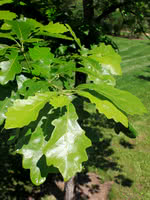Mon-Fri 9am - 5pm Mountain time
Bur Oak vs Dropmore Linden
Tilia x flavescens Dropmore
Quercus macrocarpa
CUSTOM GROW
Dropmore Linden is a dense deciduous tree with a pyramidal form.
We've discontinued Dropmore Linden to focus on other lindens with similar qualities.
Bur Oak has a wide distribution but is one of the only oaks that will grow well on the prairies. Bur Oak produces deeply lobed, dark green leaves that turn golden yellow to brown in the fall.
Its acorns are round and half enclosed by a mossy fringed cup.
Although slower growing, this long lived tree eventually becomes a popular large ornamental tree for driveways, parks, and the front of industrial buildings. Popular as a memorial or dedication tree.
Note: Most Oak species can be considered toxic for many animals.

